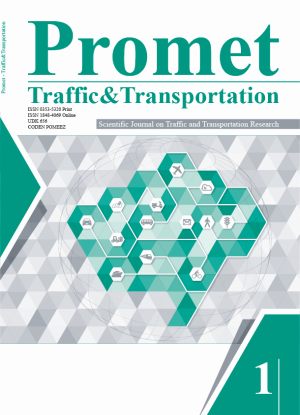Estimating Factors Influencing the Capacity of the Wide-Road-and-Narrow-Bridge Section Based on Random Forest
DOI:
https://doi.org/10.7307/ptt.v35i1.46Keywords:
wide-road-and-narrow-bridge section, road capacity, VISSIM simulation, random forest, importance ranking, rural roadsAbstract
In order to promote the modernisation process of rural roads and improve road capacity, the problem of bottleneck sections of rural roads needs to be solved urgently. The phenomenon of wide-road-and-narrow-bridge sections is particularly prominent in rural roads. Based on this, this paper analyses the degree of influence of roadway one-way lane width, bridge deck oneway lane width, motorised vehicles to non-motorised vehicles ratio, and road-bridge connection dimension on the capacity of the wide-road-and-narrow-bridge section based on the combination of VISSIM simulation and random forest algorithm. The result of the coefficient of determination (R2) of the random forest-based capacity prediction model shows that the random forest fits the data very well; the degree of influence on the capacity is in descending order of the bridge deck one-way lane width, motorised vehicles to non-motorised vehicles ratio, roadway one-way lane width and the road-bridge connection dimension. The model can, on the one hand, provide a reference for improving the capacity of bottleneck sections of rural roads; on the other hand, it can provide decision value for the order of measures to be taken when rural roads are rebuilt and expanded, according to the order of importance.
References
State Council of the People's Republic of China. [Notice of the State Council on the issuance of the 14th Five-Year Plan for Promoting Agricultural and Rural Modernization]. 2022. Chinese. http://www.gov.cn/zhengce/content/2022-02/11/content_5673082.htm. [Accessed 10th Apr. 2022].
Ministry of Transport of the People's Republic of China. (2009). [Road traffic signs and markings - Part 3: Road traffic markings]. 2009. Chinese. https://openstd.samr.gov.cn/bzgk/gb/newGbInfo?hcno=DC7BD0612CD48B8B3C81DD3EFCEA18D7. [Accessed 10th Apr. 2022].
Okamura H, Watanabe S, Watanabe T. An empirical study on the capacity of bottlenecks on the basic suburban expressway sections in Japan. Proceedings of the 4th International Symposium on Highway Capacity, 27 June - 1 July, 2000, Maui, Hawaii. 2000. p. 120-129.
Wu D, Qiu Z-J. [Operational capacity on freeway bottleneck segment]. Journal of Transportation Systems Engineering and Information Technology. 2015;15(6):147-153. DOI: 10.16097/j.cnki.1009-6744.2015.06.023. Chinese.
Raju N, Arkatkar S, Joshi G. Examining effect of bottleneck on multi-lane roads at midblock sections using simulation. Urbanization Challenges in Emerging Economies. 2018;697-705. DOI: 10.1061/9780784482025.071.
Kang L, Cheng S, Lei B. Optimization model and algorithm of urb an road traffic network design based on decision tree quantification. ICASIT 2021: 2021 International Conference on Aviation Safety and Information Technology, 18–20 Dec, 2021, Changsha, China. ACM Conferences; 2021. p. 696-699.
Zhou, J. Effects of moving bottlenecks on traffic operations on four-lane level freeway segments. Doctoral dissertation. The University of Nebraska-Lincoln; 2018.
Yong J, et al. Traffic conflict prediction model for bottleneck section of expressway construction area based on video recognition. 2019 12th International Conference on Intelligent Computation Technology and Automation (ICICTA). 26-27 Oct, 2019, Xiangtan, China. IEEE; 2019. p. 259-264.
Shiomi Y, et al. Analysis of the long-term variations in traffic capacity at freeway bottleneck. Transportation Research Record. 2019;2673(7):390-401. DOI: 10.1177/0361198119842124.
Yuan H, et al. MTCS: A method of analyzing the traffic capacity of urban bus lane base d on vissim simulation. Research Square, Preprint. 2021. DOI: 10.21203/rs.3.rs-907719/v1.
Bai X-M, et al. [Optimized random forest prediction model for u rban road congestion]. Science Technology and Engineering. 2021;21(26):11205-11211. Chinese.
Breiman L. Bagging predictors. Machine learning. 1996;24(2):123-140. DOI: 10.1007/BF00058655.
Downloads
Published
How to Cite
Issue
Section
License
Copyright (c) 2023 Hao Li, Yahong Guo

This work is licensed under a Creative Commons Attribution-NonCommercial 4.0 International License.







